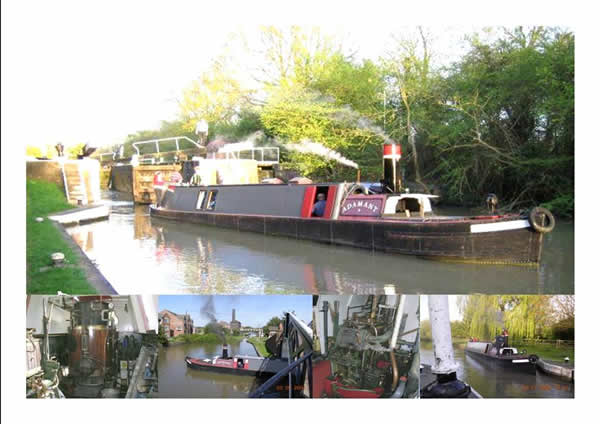ADAMANT

Although not a genuine
original, this boat is probably the closest working example of a steam canal tunnel
tug on the waterways today. This is particularly so as both the hull and engine
date from the end of the 19 th century.
The hull is built from the
stern ends of two horse-drawn Birmingham ‘Joey’ boats built of iron
in the late 1880’s or 1890’s with recent counter and cabin top.
Conceived and built as a steamer by Chris Stubbings in the 1980’s,
Adamant has never been powered by anything other than steam.
The machinery is well
forward so that the funnel in the correct steam tug position; the original boats
were little more than a floating steam engine with the machinery occupying
nearly half the boat’s length. This meant they had the necessary
‘grunt’ to tow a string of maybe 12 boats at a time.
Adamant has a compound
engine built by Cochrane of Birkenhead probably in the 1890’s (in any
event before 1902 when the company moved to Annan in
The compound engine is more
efficient than a similar size ‘Single’ as the steam is expanded
twice on its way to the exhaust. Efficiency is further increased by condensing
the exhaust steam back to water and thereby producing a partial vacuum on the
exhaust side of the engine. The resulting condensate is then returned to the
boiler by the feed pump so that the level in the boiler remains constant.
The engine runs a number of
pumps: the Feed pump noted above, a Circulating pump to pass cold canal water
through the condenser to cool the exhaust steam, an ‘Air’ pump to
extract the condensate from the condenser thus forming the vacuum and a 5-way
oil pump for engine lubrication. These all live in the wooden box at the back
of the engine and are chain driven.
The engine has
‘Stevenson’s Link’ reversing gear which changes the valve
events to reverse the direction of rotation, hence no gearbox is needed. It is
operated by the vertical lever at the front of the engine.
Steam is supplied from the
boiler, which was built in 1986. The type is a Vertical Fire Tube and it is
3’ in diameter by 3’ high with 170 1” diameter tubes carrying
the hot gasses from the fire up through the water, there is also a ‘water
wall’ surrounding the coal fire which burns at the bottom on a 2 ft
diameter grate. There is normally enough natural draft to produce the steam
required although extra draft can be produced by means of a steam blower. The
water level (most important!) is shown by the vertical glass tube behind a
heavy glass protector. Additional water feed can be supplied from the canal by
means of steam injectors. The boiler pressure is shown by the big gauge above
the boiler and normal operating pressure is round about 100 psi. The maximum
pressure is 125 psi. Coal consumption is quite low – about 3 bags per day
including lighting up – say 75-80 kgs. The group of three pressure gauges
above and behind the engine measure the pressures of the steam at various
stages as it passes through the engine.
A minimum crew of two is
required, a steerer and an engineer.
Adamant’s home base
is at Stockton (Warwickshire) and can often be seen around the midlands canal
system.
Don’t be afraid to
ask, we will do our best to answer any questions you may have.
The owner is a member of
the Steam Boat Association of Great Britain, their website is www.steamboat.org.uk
where you can find further details of the Association.
Adamant is also listed in
the Historic Ships Register, their site is www.nhsc.org.uk
|
|
|
P E Martino 2006

